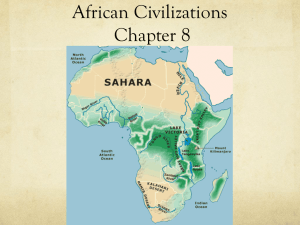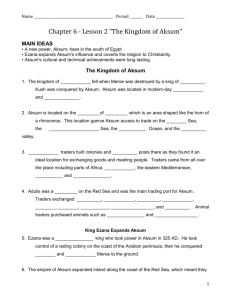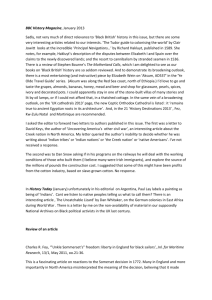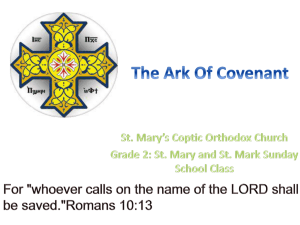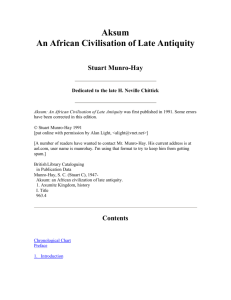Keepers of the Faith: The Living Legacy of Aksum NATIONAL
advertisement
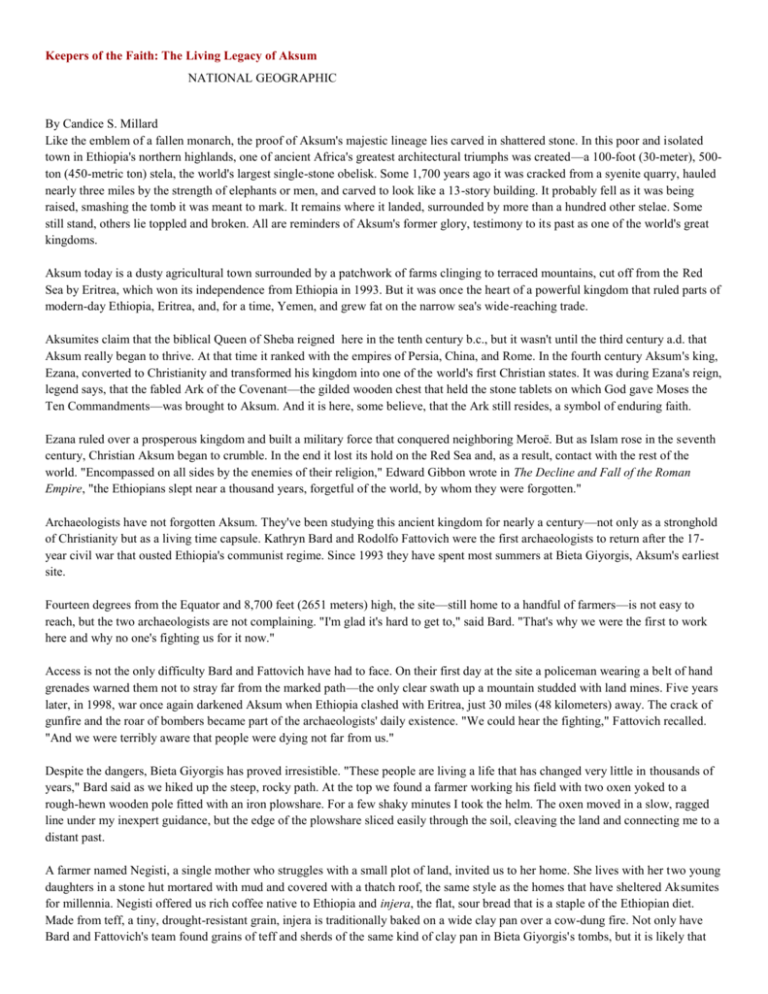
Keepers of the Faith: The Living Legacy of Aksum NATIONAL GEOGRAPHIC By Candice S. Millard Like the emblem of a fallen monarch, the proof of Aksum's majestic lineage lies carved in shattered stone. In this poor and isolated town in Ethiopia's northern highlands, one of ancient Africa's greatest architectural triumphs was created—a 100-foot (30-meter), 500ton (450-metric ton) stela, the world's largest single-stone obelisk. Some 1,700 years ago it was cracked from a syenite quarry, hauled nearly three miles by the strength of elephants or men, and carved to look like a 13-story building. It probably fell as it was being raised, smashing the tomb it was meant to mark. It remains where it landed, surrounded by more than a hundred other stelae. Some still stand, others lie toppled and broken. All are reminders of Aksum's former glory, testimony to its past as one of the world's great kingdoms. Aksum today is a dusty agricultural town surrounded by a patchwork of farms clinging to terraced mountains, cut off from the Red Sea by Eritrea, which won its independence from Ethiopia in 1993. But it was once the heart of a powerful kingdom that ruled parts of modern-day Ethiopia, Eritrea, and, for a time, Yemen, and grew fat on the narrow sea's wide-reaching trade. Aksumites claim that the biblical Queen of Sheba reigned here in the tenth century b.c., but it wasn't until the third century a.d. that Aksum really began to thrive. At that time it ranked with the empires of Persia, China, and Rome. In the fourth century Aksum's king, Ezana, converted to Christianity and transformed his kingdom into one of the world's first Christian states. It was during Ezana's reign, legend says, that the fabled Ark of the Covenant—the gilded wooden chest that held the stone tablets on which God gave Moses the Ten Commandments—was brought to Aksum. And it is here, some believe, that the Ark still resides, a symbol of enduring faith. Ezana ruled over a prosperous kingdom and built a military force that conquered neighboring Meroë. But as Islam rose in the seventh century, Christian Aksum began to crumble. In the end it lost its hold on the Red Sea and, as a result, contact with the rest of the world. "Encompassed on all sides by the enemies of their religion," Edward Gibbon wrote in The Decline and Fall of the Roman Empire, "the Ethiopians slept near a thousand years, forgetful of the world, by whom they were forgotten." Archaeologists have not forgotten Aksum. They've been studying this ancient kingdom for nearly a century—not only as a stronghold of Christianity but as a living time capsule. Kathryn Bard and Rodolfo Fattovich were the first archaeologists to return after the 17year civil war that ousted Ethiopia's communist regime. Since 1993 they have spent most summers at Bieta Giyorgis, Aksum's earliest site. Fourteen degrees from the Equator and 8,700 feet (2651 meters) high, the site—still home to a handful of farmers—is not easy to reach, but the two archaeologists are not complaining. "I'm glad it's hard to get to," said Bard. "That's why we were the first to work here and why no one's fighting us for it now." Access is not the only difficulty Bard and Fattovich have had to face. On their first day at the site a policeman wearing a belt of hand grenades warned them not to stray far from the marked path—the only clear swath up a mountain studded with land mines. Five years later, in 1998, war once again darkened Aksum when Ethiopia clashed with Eritrea, just 30 miles (48 kilometers) away. The crack of gunfire and the roar of bombers became part of the archaeologists' daily existence. "We could hear the fighting," Fattovich recalled. "And we were terribly aware that people were dying not far from us." Despite the dangers, Bieta Giyorgis has proved irresistible. "These people are living a life that has changed very little in thousands of years," Bard said as we hiked up the steep, rocky path. At the top we found a farmer working his field with two oxen yoked to a rough-hewn wooden pole fitted with an iron plowshare. For a few shaky minutes I took the helm. The oxen moved in a slow, ragged line under my inexpert guidance, but the edge of the plowshare sliced easily through the soil, cleaving the land and connecting me to a distant past. A farmer named Negisti, a single mother who struggles with a small plot of land, invited us to her home. She lives with her two young daughters in a stone hut mortared with mud and covered with a thatch roof, the same style as the homes that have sheltered Aksumites for millennia. Negisti offered us rich coffee native to Ethiopia and injera, the flat, sour bread that is a staple of the Ethiopian diet. Made from teff, a tiny, drought-resistant grain, injera is traditionally baked on a wide clay pan over a cow-dung fire. Not only have Bard and Fattovich's team found grains of teff and sherds of the same kind of clay pan in Bieta Giyorgis's tombs, but it is likely that Keepers of the Faith: The Living Legacy of Aksum NATIONAL GEOGRAPHIC ancient Aksumites also fed their fires with dung. "We have pretty conclusive evidence that this place was deforested even then," Bard said. The ghosts of Aksum were everywhere. They appeared in a girl's braids that ran in tight rows over the crown of her head and ended in an explosion of curls, echoing the hairstyles on ceramic Aksumite heads. They were in the clay water jug an old woman carried behind her back, tied with a leather rope slung low around her shoulders. She walked with her hands behind her, palms up, balancing a container nearly identical to Aksumite jugs probably used for the same purpose hundreds of years ago. In legend the story of Aksum begins 3,000 years ago, when the Queen of Sheba is said to have ruled the land. According to the Old Testament the queen, known to Ethiopians as Makeda, traveled to Jerusalem to visit King Solomon. The Ethiopian chronicle Kebra Nagast says that when she returned home, she was pregnant with Solomon's son, a child she named Menelik. Menelik is known as the originator of the Solomonic dynasty, a nearly uninterrupted line of emperors said to have ended only 27 years ago with the fall of Haile Selassie. Perhaps more important, Menelik is believed to have brought the Ark of the Covenant to Ethiopia. One legend says that the Ark came first to an isolated monastery called Tana Kirkos. The monastery, now home to some 40 Christian monks, stands at the tip of a long, stony peninsula on the eastern shore of Lake Tana, Ethiopia's largest lake, which gives its waters to the Blue Nile. A two-and-a-half-hour boat ride brought me with my guide, Worku Sharew, to the site. We scrambled up a steep path cut into the peninsula's cliff face and were met by a barefoot monk wearing a purple hat and carrying a long wooden prayer stick. With a toothless smile he led us to a low stone bench to await the arrival of Abba Baye, the keeper of Tana Kirkos's traditions. Wrapped in a brown robe of coarse cotton, Abba Baye walked slowly, leaning on his prayer stick and clutching a large brass cross. He blessed us with the cross, inviting us to press our foreheads against its cool metal, then sat beside us to tell Tana Kirkos's version of the story of Menelik and the Ark of the Covenant. When Menelik grew to be a man, he went to Jerusalem to meet his father, King Solomon. He stayed for three years, and when he left, Solomon ordered the firstborn sons of his noblemen to accompany him and sent the Ark of the Covenant to protect them. For safekeeping, Menelik brought the Ark to Tana Kirkos, where it stayed until King Ezana sent for it. The Ark is said to be hidden now in a small chapel in Aksum. It is guarded by one man—a monk named Abba Mekonen. Known as the Atang, the Keeper of the Ark, Abba Mekonen is bone thin, with soft, watery eyes and a shy smile. I asked him if he was happy to be the Atang, which is a great honor and the most solemn post in the Ethiopian Orthodox Church. "No," he said. "This is not a job of easy happiness. It is a heavy burden." Abba Mekonen, age 69, has shouldered this burden for three years and will continue to until his death. He never leaves the chapel compound, and he is the only person allowed to see the Ark. Abba Mekonen gently refused to explain this centuries-old tradition. But at Tana Kirkos when I had asked Abba Baye why I could not see the Ark, he had shrugged and said simply: "Who can look on the face of God?" Although Ethiopia's claim to the Ark is anchored only in legend and faith, the ancient origins of its Christianity are, literally, set in stone. When King Ezana converted to Christianity in the fourth century, he covered stone monuments with inscriptions in Geez (Ethiopia's first written language), South Arabian, and Greek, praising God for his military victories. Aksum's conversion is also set in gold, on coins that Ezana inscribed with crosses, and in ink, by a fourth-century writer named Rufinus. Rufinus's chronicle tells the story of Frumentius, a young Christian from Tyre who encouraged Aksum's few Christians and likely converted Ezana himself. Frumentius became Ethiopia's first bishop, and Ezana adopted Christianity as Aksum's official religion. It took 200 years for Christianity to take root in Aksum, but today more than half of all Ethiopians are Christian, some 30 million people. Their faith, because it survived in isolation here for a thousand years, is a unique blend of Old and New Testament teachings. Great devotion is shown to the Virgin Mary, for example, yet to this day Ethiopian Orthodox customs echo Judaic law, Keepers of the Faith: The Living Legacy of Aksum NATIONAL GEOGRAPHIC calling on members of the church to circumcise their male children on the eighth day, rest on the Sabbath, and abstain from pork. But many Ethiopian Christians also embrace beliefs found nowhere in the Bible. Worku Sharew bears the mark of this distinctive faith on his face, in a small, dark line to the right of his right eye. He was given this tattoo—which I saw throughout northern Ethiopia, sometimes as a cross or a double line—when he was a baby. Like the haircuts many Ethiopian parents give their children—a shaved head with a small tuft of hair just above the forehead—these tattoos are meant to protect the wearer from evil. Since perhaps the 16th century some Ethiopian Orthodox Christians have also believed in benign spirits known as zars. Worku's mother had claimed to have one, a strong-willed spirit that proudly proclaimed its Christianity and took over in times of emergency. "I was a sickly child, and my first memory is of my mother hovering over me, healing me," he said. "They say I died and she brought me back to life." When typhoid struck Worku's village, his mother's zar went to work: "She would touch her forehead to the sick person's forehead three times," Worku said, "and the sickness would transfer to her but not affect her." In the centuries since its introduction, Christianity in Ethiopia has survived many threats. The most recent took the form of the Communist regime during the 1970s and '80s, when political attempts to eliminate all religious practices in Ethiopia backfired, giving rise to a tremendous resurgence of Christianity. In the 16th century the Muslim Ahmad Gragn had more success. From the walled city of Harer in eastern Ethiopia, Gragn invaded the highlands, burning churches and forcing Christians to convert to Islam. But the historical figure Ethiopians most love to hate is Queen Gudit. The story is told that Gudit was born into a royal family in the tenth century, got into trouble, and left Aksum in disgrace. When she returned, she was armed with a lust for revenge and the military might of a king from the south. By the time Gudit supposedly attacked Aksum, the kingdom had been in decline for centuries, but Gudit is credited with delivering the fatal blow. Storming through Aksum, she destroyed churches, forced the king to hide the Ark of the Covenant back at Tana Kirkos, and, finally, invaded the capital, killed the king, and ascended the throne. Archaeologists have had difficulty finding hard evidence that Gudit existed, but Aksum probably did suffer a military defeat in the late ninth or early tenth century, when it was at its weakest—stricken by drought, famine, and a devastating plague. Broken and impoverished, the kingdom took its place in the past, and the young state that rose from its ashes moved its capital south, to an isolated town named Roha, later renamed in honor of its most celebrated emperor: Lalibela. "Aksum is the holiest city because it is the first, the oldest, and because of what it has, the Ark," Worku Sharew told me. "Lalibela is holy because of its promise: Coming here is as good as going to Jerusalem." The promise of Lalibela is not readily apparent. The land is barren and denuded, its River Jordan is just a shallow ditch that often holds only a trickle of water, and the town is deeply poor. But the promise that Worku spoke of lies not in Lalibela's land but in its 12 remarkable rock-hewn churches. Called prayers in stone, these churches—carved from cliff faces and scooped out of the living rock to stand in deep stone trenches— were molded from the region's red mountains some 800 years ago. Legend says that they were built by angels, who helped Lalibela at night while he and his legion of workers labored by day. Lalibela stands on soft volcanic tuff, easily cut without divine intervention, but it's not hard to imagine angels hovering over these masterpieces, coaxing them from shapeless stone. The most stunning is Bieta Giyorgis, a massive monolith intricately carved and shaped like a cross, all 40 feet (12 meters) of it below ground level. "This is the pride of Ethiopia," said Kese-Gebez Wedajenew Assefa, Bieta Giyorgis's priestly guardian. "It is the heritage of the whole world." As I wandered through the pink-hued passageways that wind from one church to the next, ancient Geez, still the liturgical language, echoed around me. The heavy scent of frankincense, one of Aksum's earliest exports, billowed through cross-shaped windows in gusts Keepers of the Faith: The Living Legacy of Aksum NATIONAL GEOGRAPHIC so thick that the churches seemed to be burning. Inside, the cool stone floors were slick from the friction of centuries of barefoot worshipers. Before slipping off my shoes to enter Bieta Medhane Alem, the world's largest monolithic church, I stopped to talk to a hermit hunched over a small prayer book. He said he had lived in Lalibela most of his life and that he planned to stay until his "body and soul separate." His words echoed Worku's: "I stay here because Lalibela has a promise, a covenant. He who comes here to live, he who comes here to pray, he who comes here to die will be saved." This faith, as indelible as it is ancient, has sustained Ethiopian Christians through centuries of isolation and famine, foreign occupation and civil war. It is the promise of Lalibela, and the legacy of Aksum. Honors: Describe the lasting impact of Aksum, as discussed in this article. Cite specific examples. Do you agree with article? Explain why or why not. (This must be at least two paragraphs)




